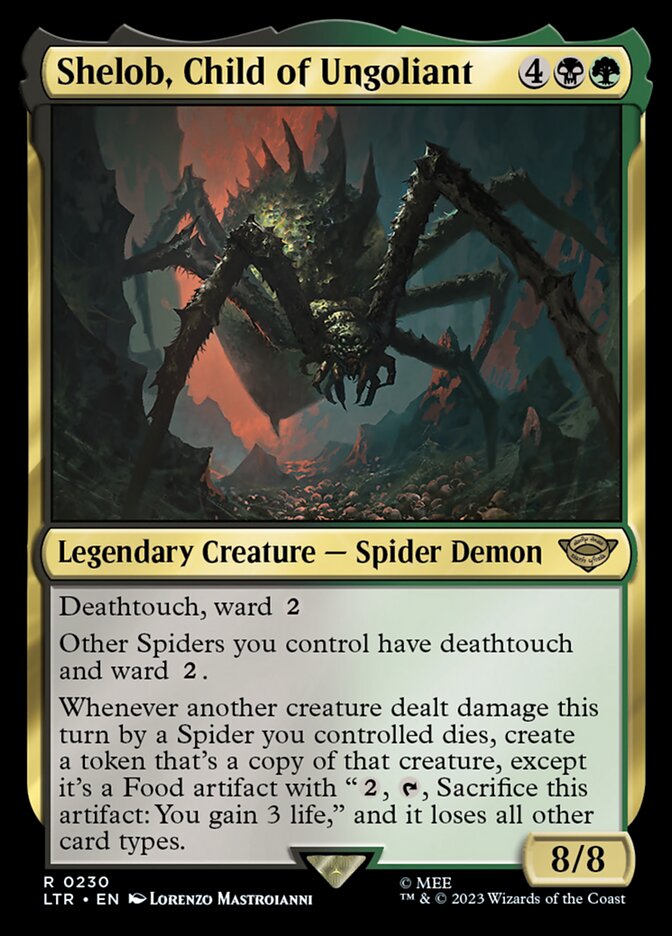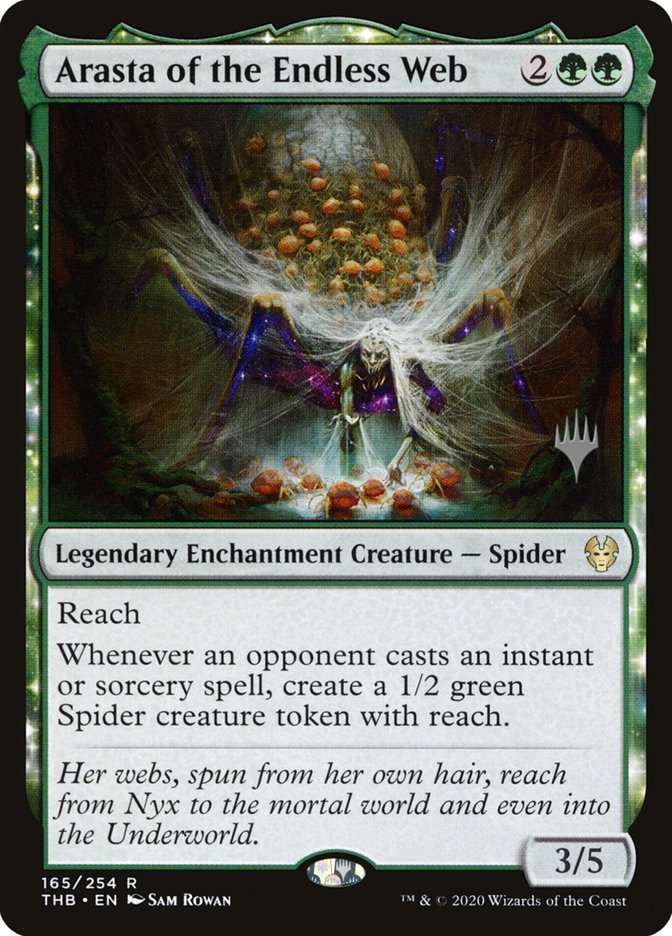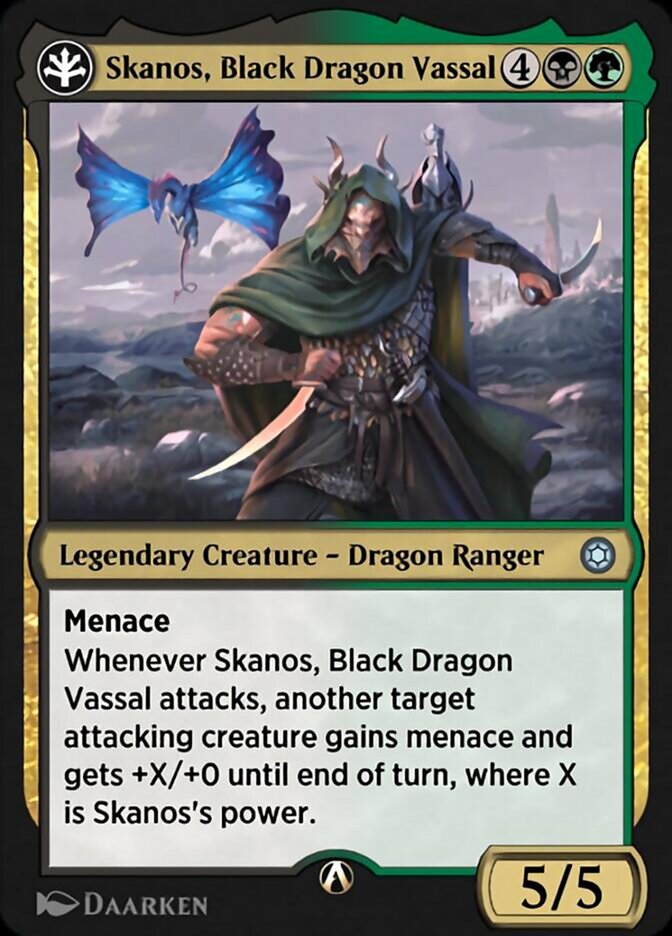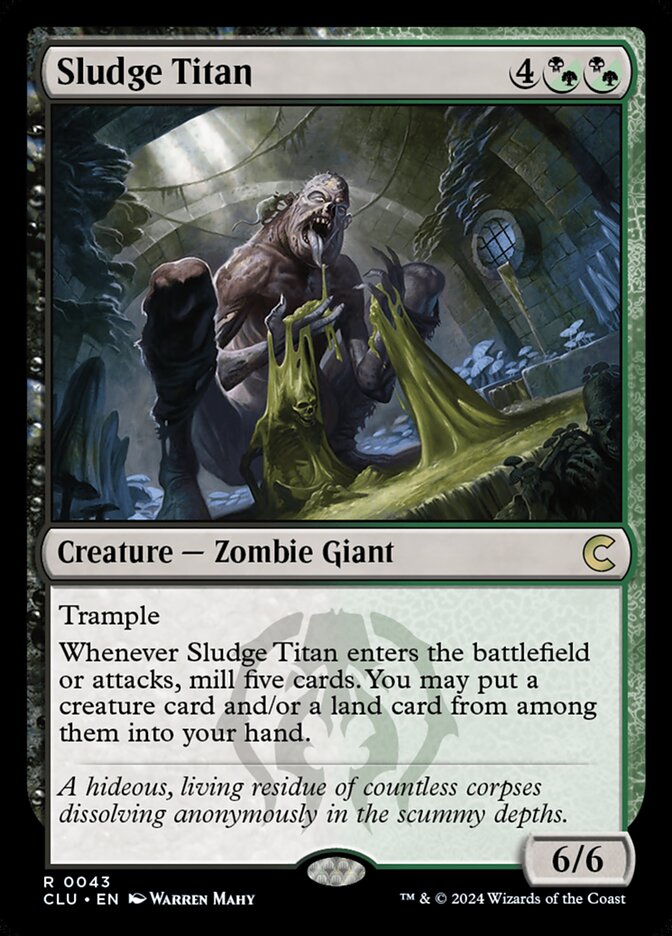Shelob, Child of Ungoliant MTG Card
| Card sets | Released in 6 setsSee all |
| Mana cost | |
| Converted mana cost | 6 |
| Rarity | Rare |
| Type | Legendary Creature — Spider Demon |
| Abilities | Deathtouch,Food,Ward |
| Power | 8 |
| Toughness | 8 |
Text of card
Deathtouch, ward Other Spiders you control have deathtouch and ward . Whenever another creature dealt damage this turn by a Spider you controlled dies, create a token that's a copy of that creature, except it's a Food artifact with ", , Sacrifice this artifact: You gain 3 life," and it loses all other card types.
Cards like Shelob, Child of Ungoliant
Shelob, Child of Ungoliant, presents a unique presence in the realm of creature cards for Magic: The Gathering enthusiasts. One parallel worth noting is Ishkanah, Grafwidow, which also taps into spider synergy. Both cards have the potential to generate a spider-themed tactical advantage, but Shelob stands out with its focus on menacing singleton combat.
Arasta of the Endless Web offers another point of comparison—both creatures thrive on the spider motif that reinforces board control with arachnid allies. Shelob, though, leans into offensive tactics by ensnaring opposing creatures, contrastingly, Arasta yields value by spinning a web of incidental token generation rooted in the opponents’ spells.
Examining these comparisons exposes Shelob’s niche role within spider tribal decks, combining aggressive strategies with creature control. While similar cards emphasize community or reactive token production, Shelob pivots towards direct control and combat dominance, placing it into a distinctive category of MTG creature cards. Thus, Shelob, Child of Ungoliant could very well weave its way into the fabric of Magic: The Gathering gameplay as a formidable force in the right deck construction.
Cards similar to Shelob, Child of Ungoliant by color, type and mana cost
Card Pros
Card Advantage: Delving into the depths of MTG strategy, Shelob, Child of Ungoliant enhances your hand by allowing for draw manipulation. Adept at spinning plots as well as webs, this card presents the player with an opportunity to craft the perfect hand, outmaneuvering opponents through superior card options.
Resource Acceleration: In the resource-hungry game of MTG, time is mana. Shelob, Child of Ungoliant can inject a surge of resources into your pool. Through its unique abilities, you gain access to additional mana, quickening the pace at which you can deploy your threats or respond to the ever-shifting battlefield.
Instant Speed: Flexibility is key in the art of MTG tactics, and this card’s instant speed attribute is the silk that binds victory. It allows you to adapt on the fly, keeping opponents ensnared in uncertainty. Such strategic depth can turn the tide, making Shelob not just a frightening foe but an indispensable ally in your deck.
Card Cons
Discard Requirement: Shelob, Child of Ungoliant mandates a portion of your hand to be discarded, which can deplete your vital resources and potentially disrupt your game strategy if not managed wisely.
Specific Mana Cost: This card’s casting cost is tailored with particular mana types. Requiring a specific combination can make it inflexible, restricting its integration solely into decks that can produce the necessary mana.
Comparatively High Mana Cost: Being on the higher side of the mana spectrum, it necessitates a significant investment before you can harness its power. This could be a setback when facing decks designed to win quickly or that can control the board before you’re able to cast it.
Reasons to Include in Your Collection
Versatility: Shelob, Child of Ungoliant, impresses with its ability to adapt across various decks. Its intricate web of abilities allows for diverse strategic plays, strengthening its position as a valuable asset in a collector’s arsenal.
Combo Potential: This card’s potential to form synergistic relationships with other cards is vast. Its traits harness the power to create powerful plays and enhance deck functionality, offering an edge during pivotal game moments.
Meta-Relevance: Shelob, Child of Ungoliant remains relevant amidst fluctuating meta environments. Its strategic significance can influence game outcomes, especially in a meta that prizes adaptability and synergy. Bringing it into play can tip the scales in favor of its controller, proving its worth in competitive scenarios.
How to beat Shelob, Child of Ungoliant
Shelob, Child of Ungoliant, is a card that poses a formidable challenge on the battlefield, with its web of abilities capable of entrapping the unprepared. To tackle this dark arachnid, it’s critical to focus on disrupting its resource-generating capabilities. This can be done by preventing it from dealing combat damage, which is key to its power. Strategic use of removal spells that can bypass its potential hexproof ability, like board wipes or targeted removal with no targeting requirement, can effectively contain Shelob’s influence.
Moreover, preventing the recursion of creatures from the graveyard stifles Shelob’s ability to gain indestructible. Cards that exile creatures from the graveyard or grave hate mechanics are excellent tools in this regard. It’s also advice worthy to maintain pressure with creatures that can outpace the growth of Shelob. Creating a board state that overwhelms your opponent before Shelob can dominate the game is often a successful strategy to claim victory over the shadowy progeny of Ungoliant.
Where to buy
If you're looking to purchase Shelob, Child of Ungoliant MTG card by a specific set like The Lord of the Rings: Tales of Middle-earth and The Lord of the Rings: Tales of Middle-earth, there are several reliable options to consider. One of the primary sources is your local game store, where you can often find booster packs, individual cards, and preconstructed decks from current and some past sets. They often offer the added benefit of a community where you can trade with other players.
For a broader inventory, particularly of older sets, online marketplaces like TCGPlayer, Card Kingdom and Card Market offer extensive selections and allow you to search for cards from specific sets. Larger e-commerce platforms like eBay and Amazon also have listings from various sellers, which can be a good place to look for sealed product and rare finds.
Additionally, Magic’s official site often has a store locator and retailer lists for finding Wizards of the Coast licensed products. Remember to check for authenticity and the condition of the cards when purchasing, especially from individual sellers on larger marketplaces.
Below is a list of some store websites where you can buy the Shelob, Child of Ungoliant and other MTG cards:
 BUY NOW
BUY NOW BurnMana is an official partner of TCGPlayer
- eBay
- Card Kingdom
- Card Market
- Star City Games
- CoolStuffInc
- MTG Mint Card
- Hareruya
- Troll and Toad
- ABU Games
- Card Hoarder Magic Online
- MTGO Traders Magic Online
See MTG Products
Printings
The Shelob, Child of Ungoliant Magic the Gathering card was released in 3 different sets between 2023-06-23 and 2023-06-23. Illustrated by Lorenzo Mastroianni.
| # | Released | Name | Code | Symbol | Number | Frame | Layout | Border | Artist |
|---|---|---|---|---|---|---|---|---|---|
| 1 | 2023-06-23 | The Lord of the Rings: Tales of Middle-earth | LTR | 230 | 2015 | Normal | Black | Lorenzo Mastroianni | |
| 2 | 2023-06-23 | The Lord of the Rings: Tales of Middle-earth | LTR | 681 | 2015 | Normal | Black | Lorenzo Mastroianni | |
| 3 | Tales of Middle-earth Art Series | ALTR | 23 | 2015 | Art series | Borderless | Lorenzo Mastroianni | ||
| 4 | 2023-06-23 | Tales of Middle-earth Promos | PLTR | 230s | 2015 | Normal | Black | Lorenzo Mastroianni | |
| 5 | 2023-06-23 | The Lord of the Rings: Tales of Middle-earth | LTR | 374 | 2015 | Normal | Black | Lorenzo Mastroianni | |
| 6 | 2023-06-23 | The Lord of the Rings: Tales of Middle-earth | LTR | 785 | 2015 | Normal | Black | Lorenzo Mastroianni |
Legalities
Magic the Gathering formats where Shelob, Child of Ungoliant has restrictions
| Format | Legality |
|---|---|
| Historicbrawl | Legal |
| Commander | Legal |
| Historic | Legal |
| Legacy | Legal |
| Modern | Legal |
| Oathbreaker | Legal |
| Vintage | Legal |
| Duel | Legal |
| Gladiator | Legal |
| Alchemy | Legal |
| Penny | Legal |
| Timeless | Legal |
Rules and information
The reference guide for Magic: The Gathering Shelob, Child of Ungoliant card rulings provides official rulings, any errata issued, as well as a record of all the functional modifications that have occurred.
| Date | Text |
|---|---|
| 2023-06-16 | Any enters-the-battlefield abilities of the copied creature will trigger when the token enters the battlefield. Any "as -his creature] enters the battlefield" or " -his creature] enters the battlefield with" abilities of the chosen creature will also work. |
| 2023-06-16 | Do not eat the delicious cards. No, not even for second breakfast. |
| 2023-06-16 | Except for being a Food artifact, having the listed activated ability, and losing all other card types and subtypes, the token copies only what was printed on the original creature (unless that creature is copying something else; see below). It doesn't copy whether that creature was tapped or untapped, whether it had any counters on it or Auras or Equipment attached to it, or any non-copy effects that had changed its power, toughness, types, color, or so on. |
| 2023-06-16 | Food is an artifact type. Even though it appears on some creatures in other sets, it's never a creature type. |
| 2023-06-16 | If an effect refers to a Food, it means any Food artifact, not just a Food artifact token. For example, you can sacrifice Lembas, an artifact card with the Food subtype, to activate the last ability of Bill the Pony. |
| 2023-06-16 | If the copied creature has in its mana cost, X is considered to be 0. |
| 2023-06-16 | If the copied creature is a token, the new token that's created copies the original characteristics of that token as stated by the effect that created that token, with the exceptions noted above. |
| 2023-06-16 | If the copied creature is copying something else, then the token enters the battlefield as whatever that creature copied, with the exceptions noted above. |
| 2023-06-16 | Since the token is a Food artifact and not a creature, it can't attack or block unless it becomes a creature somehow. |
| 2023-06-16 | Some spells and abilities that create Food tokens may require targets. If each target chosen is an illegal target as that spell or ability tries to resolve, it won't resolve. You won't create any Food tokens. |
| 2023-06-16 | The token copies the creature as it last existed on the battlefield before it died, not as it exists in the graveyard. |
| 2023-06-16 | You can't sacrifice a Food token to pay multiple costs. For example, you can't sacrifice a Food token to activate its own ability and also to activate the last ability of Bill the Pony. |




















